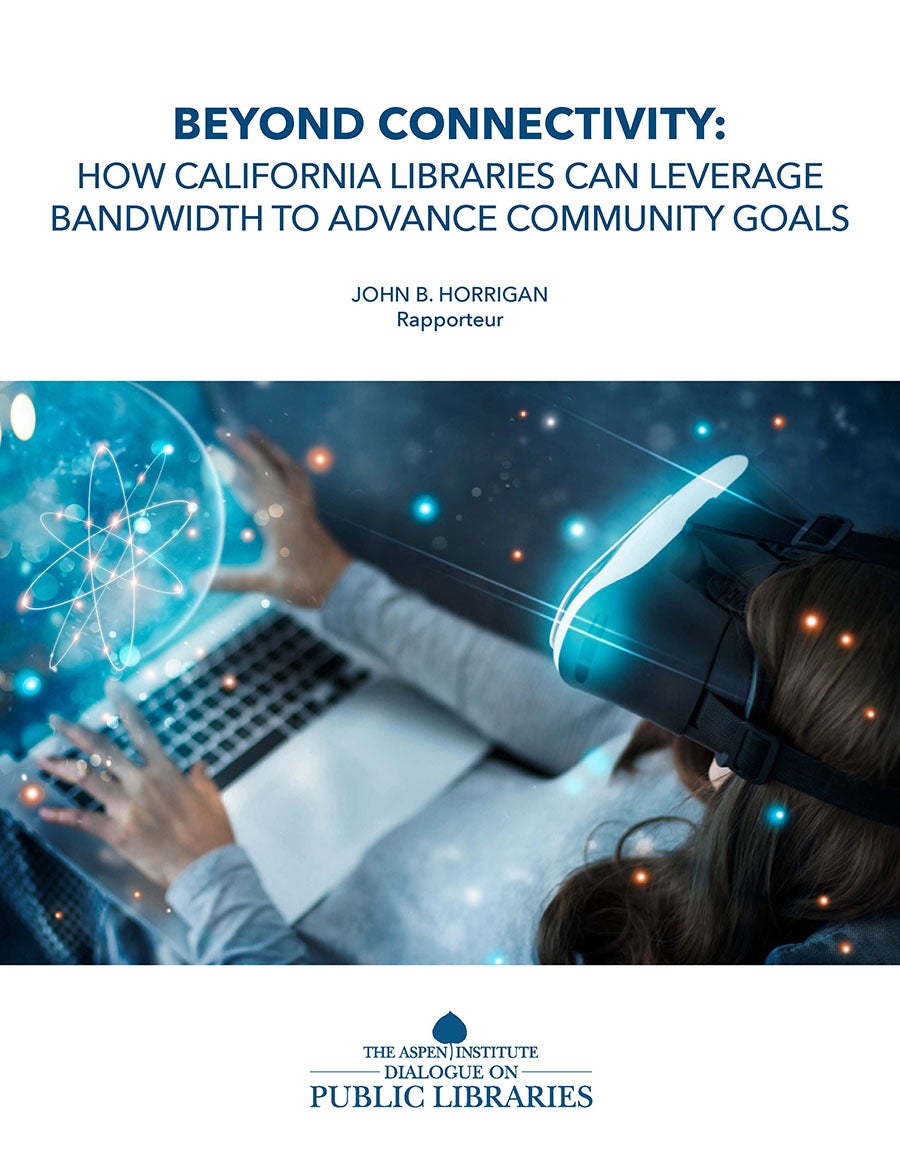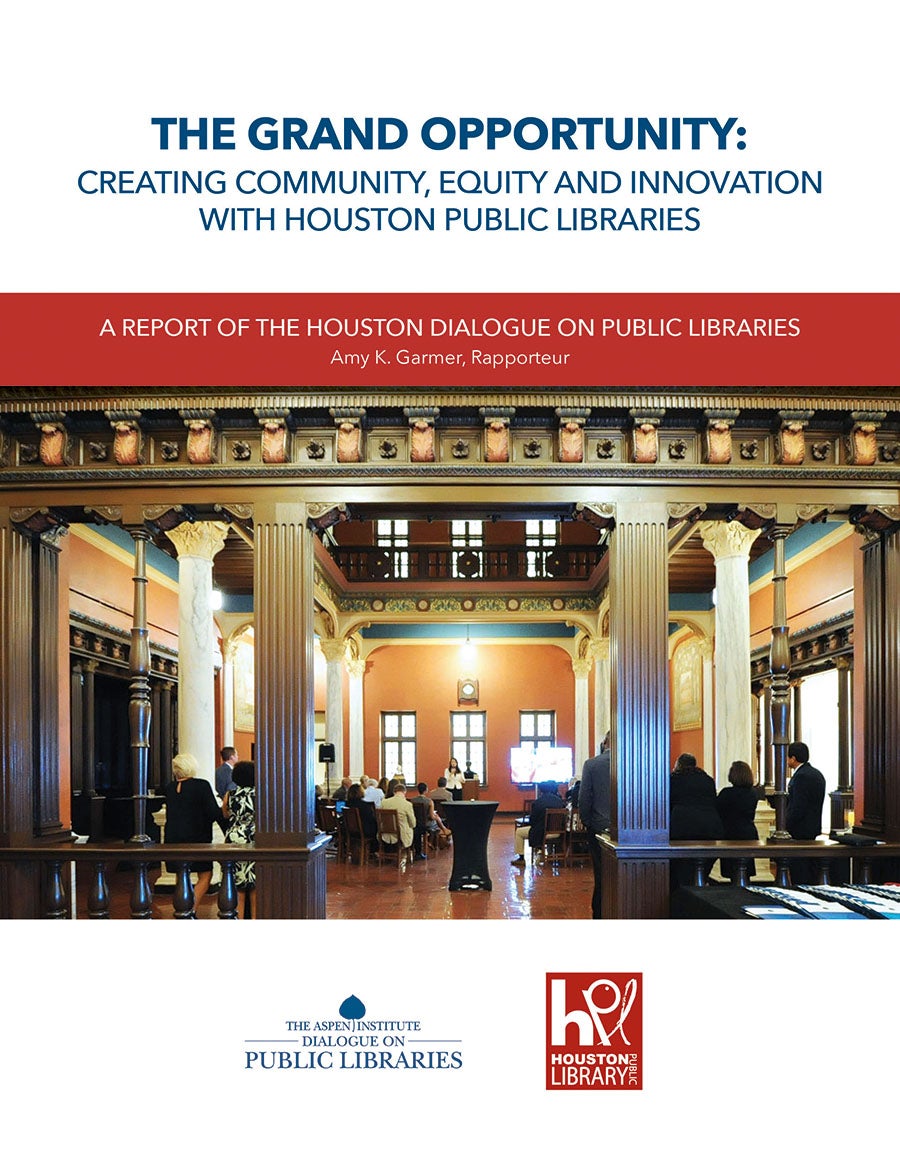“Library” is a feel-good word. It calls up childhood memories: the smell of old books and linoleum, the hum of ceiling fans. Whether an architectural masterpiece like the flagship Beaux-Arts New York Public Library, a two-room clapboard structure, or an old bus repurposed as a bookmobile, a library was a place where children felt important, where they got their first library card, were entrusted with books, and where they could imagine themselves in faraway places in faraway times.
“Every Saturday when my children were young, we would pile into the car and drive to the Wekiva, Florida, library,” Maria Vazquez, an area superintendent for the Orange County Public School System, told a group of 35 local and national policymakers, civic leaders, educators, and librarians gathered for a dinner hosted by the Aspen Institute in Winter Park, Florida. “We’d spend the afternoon scouring the shelves for books to take home. I believe it is one of the finest gifts my husband and I gave our children.”
Each of the dinner guests had a personal connection to their childhood libraries. Libraries had launched them. But as John Palfrey writes in his 2015 book, BiblioTech: Why Libraries Matter More Than Ever in the Age of Google, “Nostalgia is too thin a reed for librarians to cling to in a time of such transition.” Indeed, in a 2013 survey by the Pew Research Center, 52 percent of Americans said they did not need a library as much as they used to because they can find the information they need on the internet.
True. The internet has changed the way we fact-find. Writing on Forbes.com in 2015, innovation consultant Steve Denning asked, “Who needs a library today, when it is possible, without even getting out of bed, to read almost any book or article ever published?”
But done right, libraries are more useful—and exciting—than ever. That means serving the distinct needs of their communities, according to a report published by the Aspen Institute’s Dialogue on Public Libraries, Rising to the Challenge: Re-envisioning Public Libraries. Libraries in neighborhoods populated by immigrants need classes in English as a second language, job banks, and one-stop shopping for social services. Suburban libraries might teach library users how to scan old family photos. A library in a neighborhood with an aging population might train staff members to use blood-pressure monitors and offer access to medical information and research.
Experts argue that the library should be adapted and expanded to make technology available to everyone, strengthen communities and education, and provide a safe, neutral space for citizens to interact. It can bridge the gap between upper-income children who own iPads and lower-income children who in the age of tech will, without a public support system, almost certainly fall further behind in school.
“A library can be the gateway to things yet unimagined, and I hope that we will create that experience for future generations,” says Marina Nice, a wealth adviser and the president of the Winter Park Public Library board of trustees.
That evolution is underway at the Winter Park Public Library, selected by the Institute’s Dialogue on Public Libraries as a partner for developing the first model-community dialogue. Along with standard fare like books, DVDs, and VHS tapes, the library now lends Fitbits, bicycles, and even umbrellas for unexpected rain showers. If library users think they might want to buy a Kindle but are not sure, they can check one out and test-drive it.
The library signs up residents for cards at the local farmers’ markets. Soon the community librarian will take off on a bike paid for by the fund-raising efforts of a local Eagle Scout troop, to deliver books to day-care centers and schools. To attract 20- and 30-year-olds, the library hosts a biweekly book group called “Books and Brews” at different bars around town, and recently threw a party at a local restaurant that served a custom-brewed craft beer called the Page Turner.
The teen section sports a hip couch that the library’s youth advisers chose. And upstairs on the third floor, there are two 3-D printers, where library-card-carrying inventors and entrepreneurs can come in to make a prototype. There is also an area to record podcasts and videos.
The problem is that all of these incredible innovations are happening in a 1970s-era brown brick building with leaky windows, worn carpets, awkward angles that end in unusable corners, unreachable top bookshelves, sparse electrical outlets, and an auditorium that reeks of mildew.
In June 2015, after 11 months, 27 task-force meetings, five community forums, a presentation before the Winter Park Chamber of Commerce, a listening session with the Teen Advisory Board, six commissioner workshops and meetings, a Winter Park user-needs and transportation survey, consultations with local and national experts, and a close look at site options, the City Commission voted unanimously to proceed with a new 50,000-square-foot library and an 8,500-square-foot event space with parking adjacent to Martin Luther King Jr. Park.
With voter approval of a $30 million bond referendum, the library and city are moving ahead. They selected David Adjaye, the architect behind the National Museum of African American History and Culture, to design the complex. Winter Park’s leaders and residents expect the building to make a strong visual statement—an expression of both the dynamism inside the library and of Winter Park.
The next step is for the library to incorporate and execute all of these ideas. As David Odahowski, president and chief executive of the Edyth Bush Charitable Foundation in Winter Park, says: “It only took us 131 years to discover the future of libraries.”

